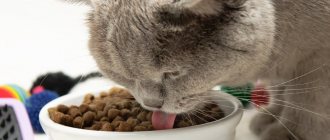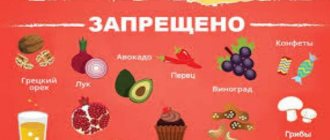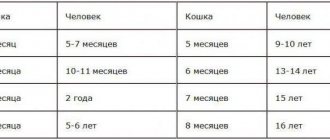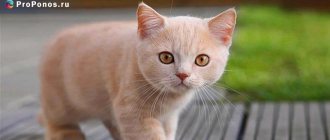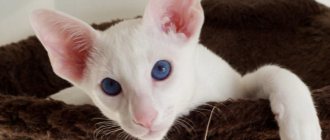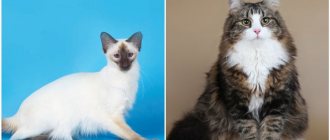Ready-made cat food is now easy to purchase at any pet store. They are convenient to use if the owner is at work all day and sometimes doesn’t even have time to prepare food for himself; besides, dry croquettes can be left in the feeder for the whole day without fear that the food will spoil. However, many pet owners prefer to switch their pets from commercially prepared food to a natural diet.
Sometimes the reason is necessity, when ready-made food is not recommended for cats for health reasons. And often the owner or mistress switches the pet to food prepared with their own hands, knowing that it is closer to the natural diet of cats than what is offered in canned form. Besides all that, cooking is a fun activity. You need to study the needs of the cat’s body, find and try to prepare interesting cat dishes.
First of all, you should know what products and in what quantities should be included in the cat’s menu so that it is complete and balanced in terms of substances necessary for its body. You should also learn how to prepare homemade cat food: what can be added to dishes raw, and what must be heat-treated.
Composition of diet for cats
A cat is a predatory mammal of the cat family. Like all predators, it mainly feeds on meat. Meat products should make up up to 80% of a cat's daily diet, of which 10% can be in the form of offal. Any meat can be used, only pork in limited quantities - it is harder to digest and contains a lot of fat.
The remaining 20% of the cat's diet should be vegetables, grains, potatoes, legumes, herbs, eggs (2-3 per week, no more). Vegetables for cats include cabbage (Brussels sprouts, broccoli, cauliflower), carrots, spinach, celery, pumpkin, and zucchini. Whatever your cat prefers, put it on the menu. Onions and garlic should not be given to cats - these products are toxic to cats. Homemade food should contain a sufficient amount of vitamins and minerals, so it is recommended to add vitamin-mineral pills or tablets for cats recommended by a veterinarian to ready-made meals.
It can be difficult for a cat to immediately switch from canned food to a natural diet, so it is wiser to start by giving her wet canned food; they are closer to homemade food in appearance and taste. If there are other animals in your house (for example, a dog), you will have to prepare food for the cat separately, since the composition of the diet for them is different: the cat needs much more protein. There are quite a lot of simple recipes for dishes for cats, at least some of which your pet will definitely like.
Smooth transition to a new diet
Switching to a new diet is a big event in a cat's life. Some animals switch to natural food faster and easier, while for others it is more difficult. How each cat reacts depends on its eating habits.
- The meat has almost no smell. If a cat is accustomed to dry food, to which manufacturers add flavorings and flavor enhancers, she may not even understand at first that there is something edible in front of her.
- Young cats and cats that eat canned foods make the transition to raw meat more easily.
- Different cats have different preferences. Perhaps your cat likes rabbit meat and doesn't like poultry meat.
First steps
Before switching your pet to a new diet, make sure he has no health problems. If your cat is sick, first discuss switching to a healthy diet with your veterinarian. Switching to a new food can affect your pet's well-being if his body is not in order.
Before switching to natural food, gradually give up dry food. If there is always food in your cat's bowl, you should stop eating this type of food. You can't feed your pet treats either. Cats should not nibble throughout the day.
Make a meal schedule: how many times a day and at what time will the cat eat? Adult animals are usually fed 2-4 times a day; kittens under one year of age need to be fed more often. Kittens are still growing and need more calories.
The transition to a healthy diet will take about 10-14 days. This is a labor-intensive process, but the results will not keep you waiting.
Did you like the article? Tell your friends:
Comments
Meat dishes
Meat serves as the main source of proteins and fats. Chicken, turkey, and beef are suitable for cats, but it is advisable not to give pork to your cat often.
Raw chicken with vegetable pilaf
For pilaf you will need: 1 cup of brown rice, two large carrots, several stalks of celery and a cup of green peas or green beans. Pre-steam the rice, grate the celery and carrots on a coarse grater. Pour 2 cups of boiling water over the mixture of rice and vegetables and cook for 20-30 minutes. Cool the finished pilaf to room temperature, add 2 tbsp. vegetable oil (preferably olive oil). This amount of pilaf is enough for several feedings; it can be stored in the refrigerator for 2-3 days. Before giving the cat the required portion, you need to add raw skinless chicken fillet cut into small cubes to the vegetable pilaf.
Chicken with mashed potatoes and eggs
Boil 2 potatoes cut into pieces, cool to room temperature. Place in blender, add 1 tsp. butter, 100 g raw chicken, 1 egg. Mix the ingredients until pureed. This dish is great for small kittens and old cats. If you use boiled chicken, this food can be prepared for future use, for a couple of days, and stored in the refrigerator.
Meat with broccoli puree
Ingredients:
- raw beef - 100 g;
- broccoli or cauliflower - 50 g;
- vegetable fat - 0.5 tsp;
- calcium gluconate - 1 tablet.
Cut the beef into small pieces, separate the cabbage into florets, boil and grind in a blender, grind the calcium gluconate tablet into powder. To prepare the dish, you can use canned cabbage from baby food. Mix everything, pour oil on top.
Meat pancakes
Grate a small carrot, 100 g of frozen chicken fillet or beef meat on a coarse grater (you can use ready-made minced meat). Add a calcium gluconate tablet, a handful of finely chopped nettles or lettuce, ¼ cup green peas, 1 raw egg. Form small cakes and bake in the oven or microwave - lightly, just so that they do not fall apart. These pancakes can be stored in the freezer and warmed in the microwave as needed.
By-products for cats are the only source of calcium
The most common mistake in natural feeding of cats is a violation of the ratio of calcium and phosphorus in food. For adult animals, the Ca:P balance should be approximately 1.2-1.7:1, for kittens 2:1. At the same time, most products, including meat, contain much more phosphorus than calcium.
The only chance to enrich the natural diet with calcium is to feed your pet not only meat, but also bones. To do this, chicken necks and heads are introduced into the diet.
Chicken heads: Cat's dinner can look creepy
Depending on the size and habits of the cat, chicken necks give:
- Entirely;
- Cut into pieces;
- Scrolled through a meat grinder as part of a meat mix.
Whole, sliced and twisted chicken necks
The hard and sharp beak is cut off from the chicken heads, and the heads themselves can first be beaten with a hammer.
Rules for feeding cats with bone by-products:
- Bones are given ONLY IN RAW FORM. Boiled bones are dangerous for cats.
- Bones should make up about 10% of the diet, which means 20-30% meat and bone ingredients.
- If the cat's feces become dry, white, or bowel movements are irregular (constipation), bones are excluded from the diet or their quantity is reduced.
- They only give spongy bones, not tubular bones (legs and wings are not allowed).
If you are afraid to give your cat bones or she cannot eat them for health reasons (diseases of the gastrointestinal tract, lack of teeth, etc.), calcium should be added to the diet in the form of commercial veterinary supplements.
Fish dishes
Fish contains minerals, essential amino acids, is rich in fat-soluble vitamins, and, like meat, serves as a source of protein. The following are suitable for preparing cat dishes: pollock, hake, cod, mackerel, pike, salmon, halibut, trout. Low-fat fish is an excellent food option for overweight cats, but due to its low calorie content, it is not recommended for pregnant and lactating cats, as well as kittens.
Salmon with rice and egg
Separate 100-150 g of salmon from skin and bones, cut and stew or cook in a double boiler. Boil ¼ cup of rice until it becomes a mushy porridge, hard-boil 1 egg and finely chop. Mix everything, add a couple of tablespoons of vegetable fat, a few finely chopped sprigs of dill or parsley, a tablet of vitamin-mineral complex or calcium gluconate. This dish can be prepared for future use and stored in containers or bags in the freezer.
Fish dish for gourmets
Boil the fillet of sea or river fish and cut into small pieces. Cook the rice like regular porridge, grate the raw carrots. Mix all ingredients, adding sprouted wheat and olive oil. For one serving of the dish you will need:
- 250 g fish fillet (it can be replaced with a can of canned fish in oil);
- 4 tbsp. rice;
- 1 small carrot;
- 1 tbsp. sprouted wheat;
- 1 tbsp olive oil.
Shrimp salad
Ingredients:
- 0.5 cups of small shrimp or 4-5 large pieces;
- 1 medium sized carrot;
- 0.5 hard-boiled egg;
- 1 tsp olive oil.
Boil the shrimp for 10-15 minutes, remove the tail part, remove the shell, chop with a knife. Grate the raw carrots and hard-boiled egg or chop in a blender. Mix everything and add vegetable fat. Even the pickiest cats eat such a tender and tasty salad with gusto.
Offal dishes
The internal organs of animals and birds are very useful for cats. They contain proteins, fats, essential amino acids (including taurine, which is so important for the cat’s body), vitamins and minerals. If your cat is reluctant to eat liver, heart or kidneys, these by-products can be included in meat or fish dishes, or their taste can be masked with grains or vegetables.
Tender pate from chicken by-products
To prepare a portion of pate you will need:
- 200 g chicken giblets (heart, liver, gizzards);
- 1 tbsp. butter;
- 1 carrot;
- several sprigs of parsley or celery.
Lightly fry the giblets in oil, boil the carrots. Pass everything through a meat grinder and add finely chopped greens.
Liver with cabbage and oatmeal
The recipe is for 4-5 servings. The pilaf can be put into bags and frozen, then you can only take the bag out of the freezer and warm its contents.
For the dish you will need:
- 0.5 kg of liver (chicken, rabbit or beef);
- 1 cup oatmeal;
- 0.6 cups of broccoli or green peas;
- 2-3 tbsp. sunflower or olive oil.
Boil the liver and cabbage and cut into small pieces, steam the oatmeal with boiling water. Mix everything, adding vegetable fat.
Stew from offal and vegetables
For 4-5 servings of the dish you need to take:
- 0.5 kg of chicken giblet mixture;
- 1 small carrot;
- half a medium-sized zucchini;
- 1 glass of pearl barley, buckwheat, oatmeal or corn;
- 2-3 tbsp. l. olive oil.
Make minced meat from raw offal, grate the vegetables on a coarse grater, and cook the cereal. Mix everything, add oil. This dish can be prepared for future use and stored in the freezer, packaged in bags.
Natural cat food, recipes
Content
- 1. Chicken dinner
- 2. Cat's joy
- 3. Delicious balls
- 4. Barley porridge with pieces of chicken breast and carrots.
- 5. Stout guy with a mustache
- 6. Calcium recipe.
- 7. Homemade organic cat treats.
- 8. For busy people
- 9. Meat mixture with rice and carrots
- Bon appetit!
Since Bengal cats are predators, their natural food is mice and birds, which consist of the following components: 55-56% proteins, 23-24% fats, 8-9% ash residue and some leftover food in the stomach in the form of grains or vegetables .
You can recreate this balance of ingredients in homemade food for your pet.
Let's look at recipes for preparing natural dishes for your cat:
Chicken dinner
Ingredients: Chicken fillet – 500 gr. Chicken gizzards – 500 gr. Chicken hearts – 250 gr. Cereals (wheat, barley, rolled oats, pearl barley, buckwheat) – 150 gr. Carrots – 150 gr. Vegetable oil
Recipe: Boil meat and offal, cut into pieces. Boil cereals and vegetables in broth. Mix everything. Before serving, add a couple of drops of vegetable oil. Divide the rest into bags and freeze.
Cat's joy
Ingredients: 1 kg chicken (fillet) 2 kg beef/veal (with veins) 1 kg chicken hearts 1 veal heart 1 zucchini 300 g oatmeal 15 Calcid tablets
Recipe: Finely chop the zucchini and boil for 5 minutes, add oatmeal and cook until tender. It turns out to be a medium thick porridge. Let it cool. Also boil 300 grams of beef (finely chopped) for 5 minutes. Rinse in a colander. Pass 300 grams of chicken hearts and a completely (without fat) veal heart through a meat grinder (large mesh). Cut the chicken fillet and the remaining beef into medium pieces (for chewing). Place the chicken hearts whole (trim off the fat). Then mix all the products in a basin. Break the Calcid tablets with a hammer to a powder state. Pour into the mixture and mix everything again. Then we pack it into bags in portions and put it in the freezer for three days. Ready)))). Defrost by throwing the bag into water. When serving, add vitamins to each serving.
If you still prefer factory-made food, then choose high-quality food, for example, Blitz. Blitz cat food offers high-quality ingredients, affordable prices, and a healthy pet.
Delicious balls
Ingredients: Meat – 500 gr. (chicken, beef, offal) Hercules – 100 gr. Egg – 1 pc. Carrots – 100 gr.
Recipe:
Add cooked rolled oats, boiled carrot puree (five minutes in the microwave), and a raw egg to the prepared ground beef or chicken.
Roll into tiny balls and place them on a large board. Place in the freezer. Then pour it into a bag and screw it up to get rid of all sorts of odors. Easy to defrost! They are small!
4. Barley porridge with pieces of chicken breast and carrots.
Ingredients (for 1 serving): Chicken breast 100 gr. Barley groats 50 gr. Carrots 20 gr. Water 15 gr.
Recipe:
The breast fillet is separated from the bones and cut into small, small cubes (or minced in a meat grinder) and frozen. When boiling barley, soak it overnight to make it cook faster. Grate the carrots on a coarse grater (boil first). Mix chicken fillet scalded with boiling water, carrots, porridge + a little boiling water to make it softer and warmer.
Mustachioed tough guy
This dish should be used as the main food if you want to fatten an exhausted or weakened cat. After a couple of weeks, the pet’s coat will become shiny, its sides will be rounded, and it will become cheerful and playful. Ingredients: 1 kg of beef 1 kg of chicken legs 0.5 kg of pink salmon 5 eggs 1.5 kg of raw liver or heart rice - 300 gr. olive oil.
Recipe: Remove fat from meat and remove skin from chicken. Separate the fish from bones and skin. Cut everything into small cubes, put it in a saucepan, add a small amount of water (so that the liquid just covers the layer of meat) and simmer over very low heat for about an hour. Separately, cook the rice until smooth. Mix it with meat and eggs (up to 1/3 of the volume), add 1/4 cup of olive oil and heat, stirring, for another 10 minutes. Place into portioned bags and freeze. Give your cat food warm!
Calcium recipe.
Ingredients: 2 tbsp. sour cream 2 tbsp. cottage cheese, grated boiled egg, eggshell powder on the tip of a knife
Recipe:
Mix everything, add a quarter teaspoon of burdock oil. This dish is 2 times a week!
7. Homemade organic cat treats.
If your kitty loves crunchy treats, then try making these easy and healthy organic treats!
Ingredients: 500 gr. skinless, boneless chicken thighs 1 cup fresh spinach leaves 1 cup oatmeal 1 egg 1 tbsp. spoon catnip 1/4 cup flour
Recipe: 1. Preheat the oven to 180 degrees. Cook the meat without oil. Let the chicken cool for 20 minutes before the next step. 2. Place the chicken, oats, spinach leaves, egg and catnip in a blender or food processor and blend on low speed. The mixture should resemble wet sand in consistency. 3. Transfer the mixture to a bowl. Add flour. Knead the dough until it no longer sticks to your hands, then turn it out onto a floured counter. 4. Roll out the dough into a layer 1 cm thick. Cut the layer into small pieces. 5. Place the treat on parchment and bake for 20 minutes.
Be sure to let the treat cool before eating!
For busy people
For 1 kg of raw ground beef: 2 medium grated carrots (without nitrates), 200 g of kindergarten cheese (cheap, mild, unsalted), 1 raw chicken yolk (or 3 quail) for binding, a tablespoon of brewer's yeast (this is the entire group of B vitamins from B1 to B12), calcium gluconate (common chalk) – 6 tablets (put in a tablespoon, rub to powder form), vitamin D – 20 drops.
The amount of meat can be increased 2-5 times, correspondingly increasing the amount of other products.
Use your hands to turn the entire mixture into a homogeneous mass. Roll out with a rolling pin into 0.5 mm layers and put in the freezer. A layer of parchment or foil is a layer of mixture.
We came home from work. Tear off a piece, quickly defrost it, make small meatballs, which increase in size as the cat ages.
Meat mixture with rice and carrots
200-300 gr. meat (beef heart, beef, chicken breast, lamb heart, all this “or”) is ground in a large meat grinder, rice is added - a good handful and grated carrots - 1 medium or small, filled with water so that about one and a half cm of the blanket on top and after it boils, all this gruel is cooked, stirring, for 20-30 minutes. over low heat so that the result is definitely a broth.
For adults, I add 1/2 tsp of olive or other vegetable oil during cooking. Well, with this diet, let’s not forget about vitamins with taurine and biotin. It can be stored in the refrigerator for no more than 3 days, so calculate the portion in advance.
Bon appetit!
Soups
Soups should be an integral part of a cat's natural diet. The body of these predators needs fiber, which is contained in boiled vegetables and grains, and during the cooking process, many useful substances pass from meat or fish into the water. Cats suffering from stomach or intestinal diseases and small kittens especially need warm soups.
Meat soup with semolina and yolk
100 g of meat scraps or chicken, a small washed and peeled carrot, pour 0.5 liters of water and cook for half an hour. Then, stirring vigorously, add 1-2 tbsp semolina, 1 tsp. butter, raw yolk, keep on fire for another 5 minutes. Before serving, the meat can be removed from the soup and finely chopped with a knife.
Diet chicken soup with broccoli
Boil chicken meat (about 100 g) in a glass of water, cook several broccoli florets in a double boiler. Grind the ingredients in a blender until pureed, pour in lukewarm broth, add 1 tsp. butter. This dietary dish is enjoyed by both adult cats and kittens; it is also recommended to be prepared for picky cats who have a habit of eating meat and leaving vegetables in the feeder.
Low calorie fish soup
Low-calorie dishes are recommended for spayed and neutered animals, as well as for old cats prone to obesity. To prepare fish soup you will need:
- 0.5 l of water;
- 100-150 g of lean fish (hake, pollock, pike);
- small carrot;
- 2 tbsp. any cereal;
- ¼ tbsp. sunflower oil (optional).
Cut the fish, cook over low heat along with cereals and grated carrots for 0.5 hours. Then remove the fish, remove the spinal bones, cut and return to the broth.
Cream soup with meatballs
Products:
- minced meat (any except pork) - 100-150g;
- rice - 1-2 tbsp;
- carrots (small piece);
- green beans or green peas - 2 tbsp.
Method of preparation: cook rice and vegetable soup in 0.5 liters of water, 10 minutes before the end of cooking, add small meatballs formed from minced meat. Remove the meatballs, beat the rest with a blender, then return the meat balls to the soup. There is no need to crush them; the cat will prefer to take out whole pieces of meat from the soup.
By-products to increase calorie intake
Some parts of the carcass contain woefully little protein but are high in fat. And some, such as testes, are a source of protein and fat at the same time. Fatty by-products should not be given to cats with impaired liver or pancreas function, as well as animals prone to obesity. But they serve as an excellent energy boost, for example, for nursing cats or stud cats.
Testes (bovine, lamb)
Although the seeds are considered a delicacy in many cuisines around the world, they are quite difficult to find for sale. They don’t have to be included in your cat’s diet for it to be complete, but if the opportunity arises, be sure to let your pet try them.
Beef testes
The testes contain a lot of protein and fat, B vitamins and microelements (zinc, manganese, copper, nickel).
There is no need to be afraid of the hormones supposedly contained in the testicles. Their concentration in the testes is negligible, since all produced testosterone immediately enters the blood.
The testes are given raw or lightly boiled (7 minutes after boiling). Before giving them to a cat, remove the thick shell from the testicles and cut them into pieces. The norm is 5-10% of the diet, while it is permissible to feed the testes in a separate feeding, without mixing them with meat.
Beef udder
Udder is a cheap and nutritious product, but I recommend feeding it to cats with caution. The dry udder consists mainly of fat and rough connective tissue, which is difficult to digest. The milk udder has a more delicate consistency and a pleasant sweetish milky smell and taste. But cows are rarely slaughtered for meat during lactation without a good reason; usually these are sick animals. Therefore, the milk udder must be carefully checked for signs of mastitis (pus, inflamed areas).
The udder contains about 12% incomplete protein and 14% fat. It is given to cats in order to increase the calorie content of the diet, in an amount of no more than 5% of the total diet. This product is fed both raw and cooked (the broth after cooking is not used for feeding). The udder has a rubbery consistency, it is very difficult to chew or bite off a piece, so you need to cut it into convenient pieces in advance. The easiest way to cut a frozen product is to use a very sharp knife.
Brain
Beef brains can be difficult to find commercially because they are perishable. But if you give your cat chicken heads, then when she eats them, she also gets brains. The value of brains lies in the fats they contain. These are omega fatty acids, lecithins and cholesterol. The brain also contains a lot of choline (B4).
Beef brains, if you were able to buy them, are not fed in their pure form, but are added to the meat mixture. The high fat content of this offal causes severe diarrhea in cats if the dosage is overdone. Brains are given in the amount of 2% of the total diet. They can be especially useful for cats exhausted by pregnancy and lactation, as they increase the calorie content of food.
